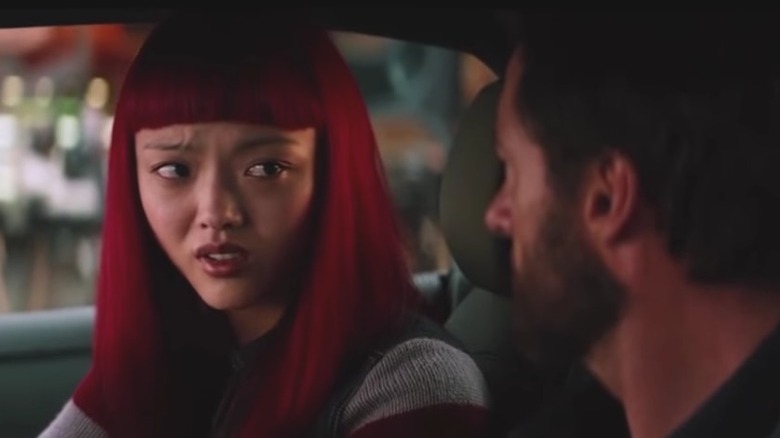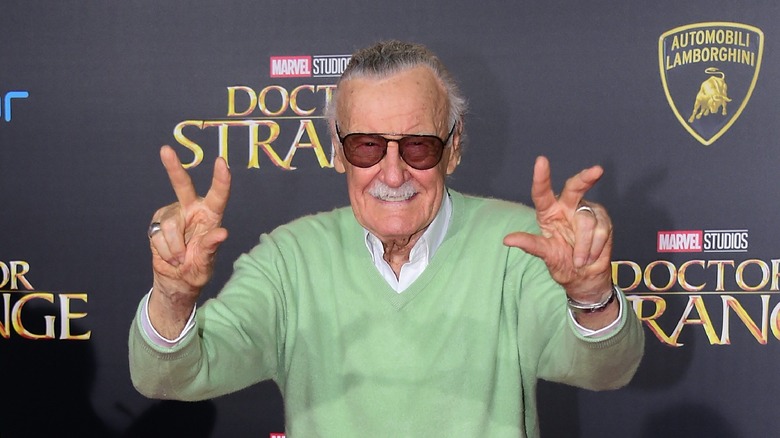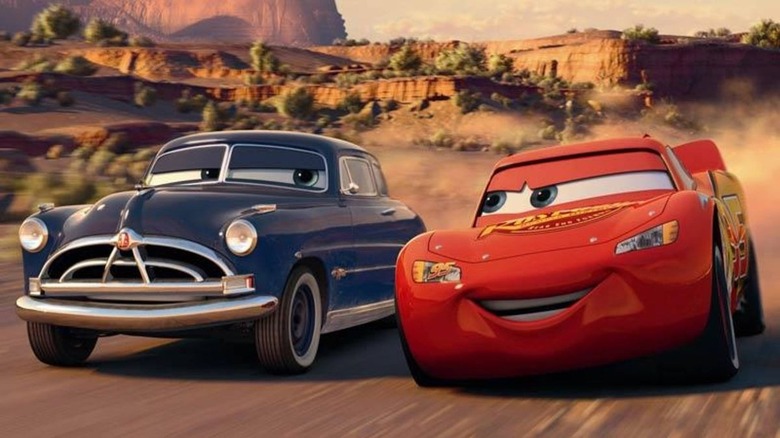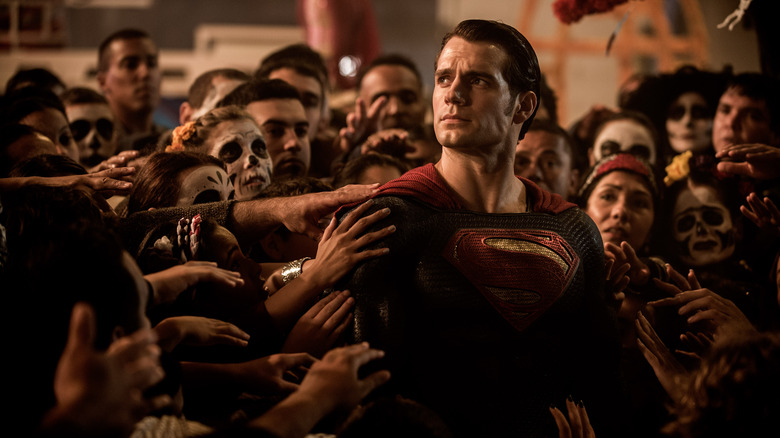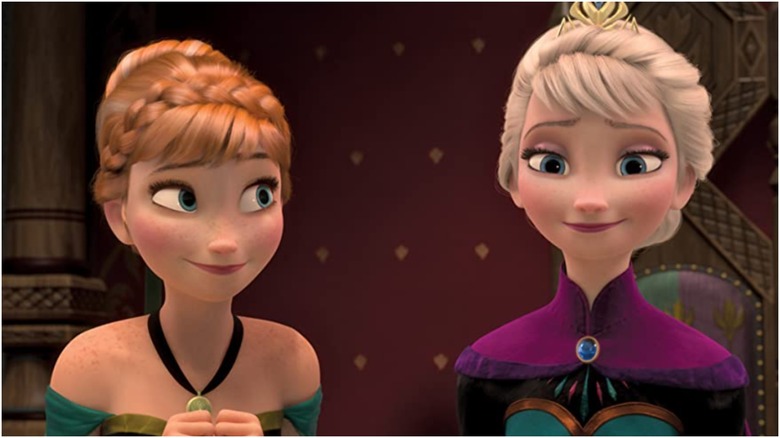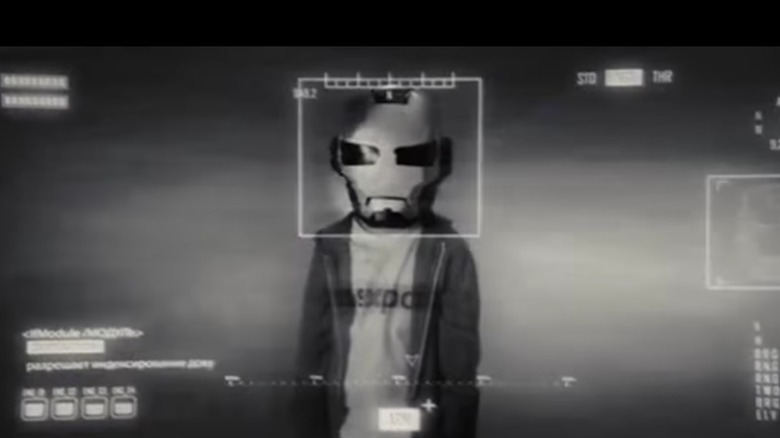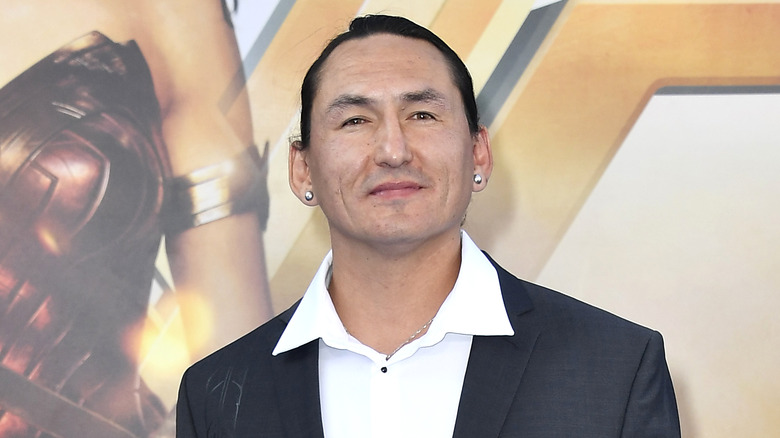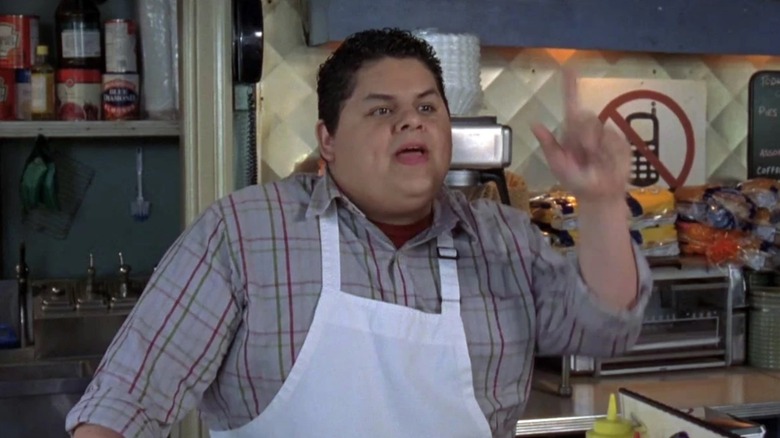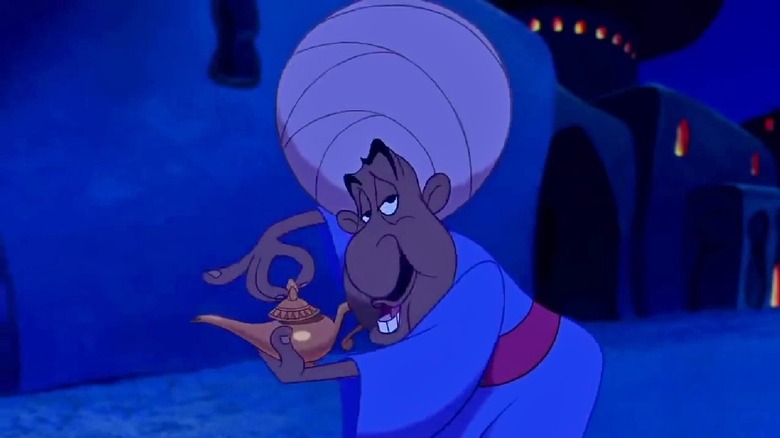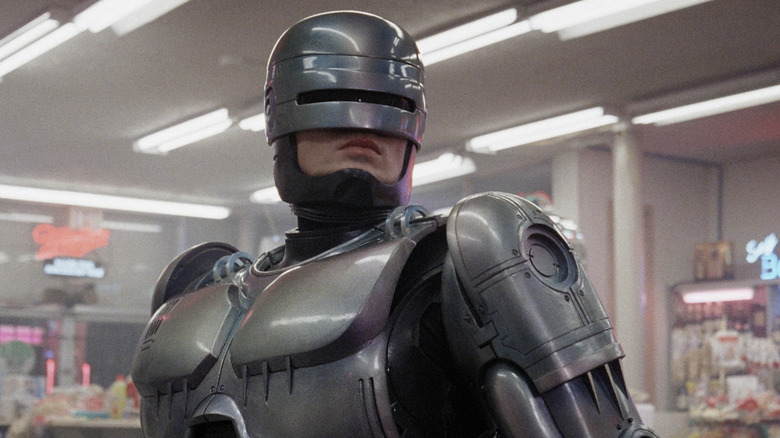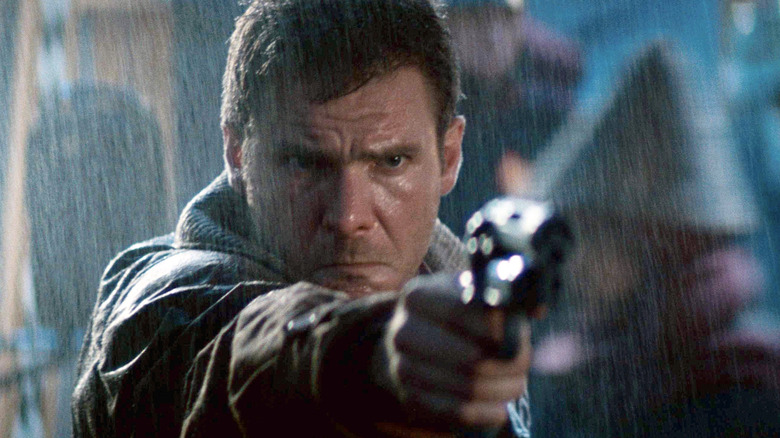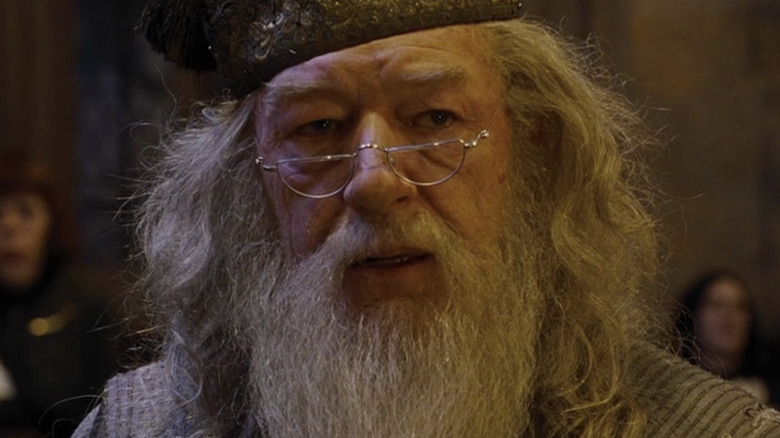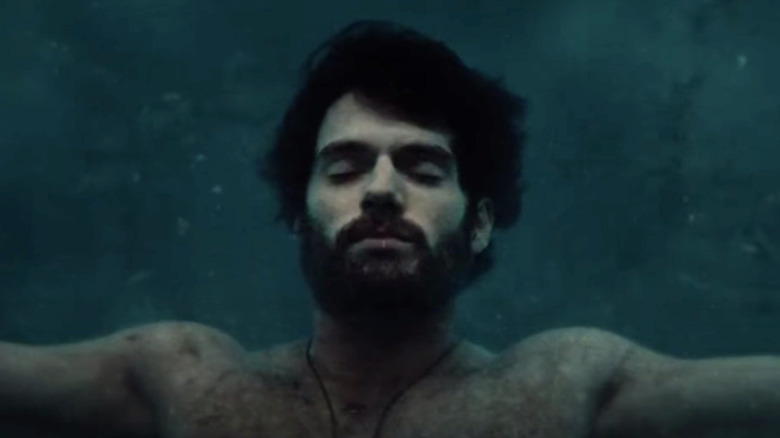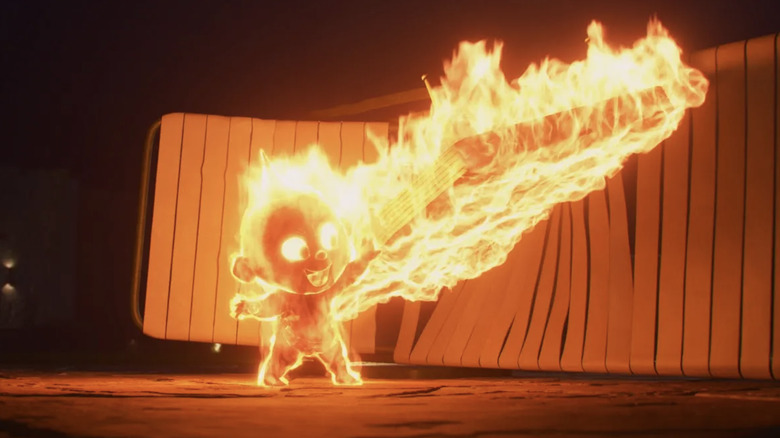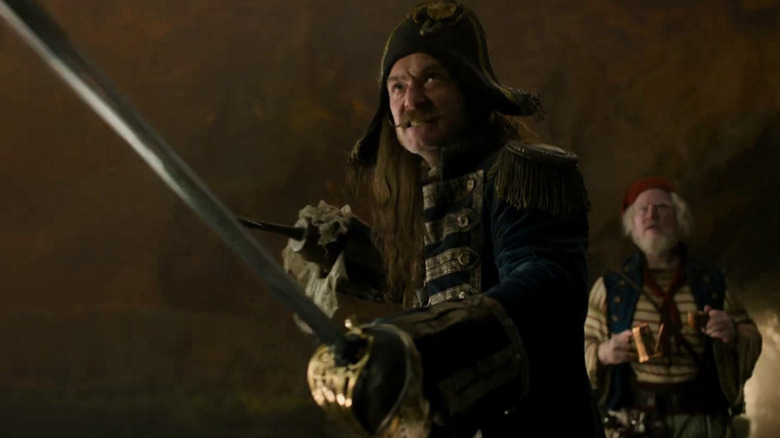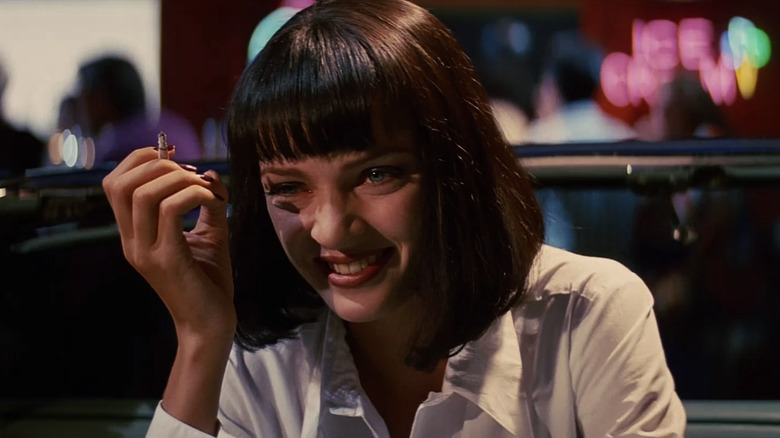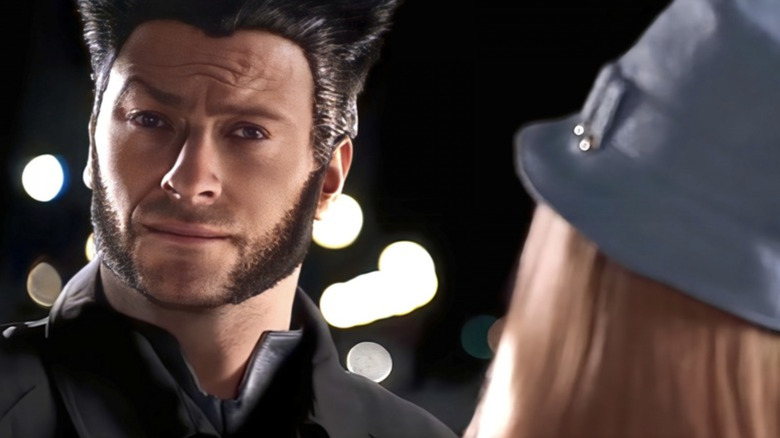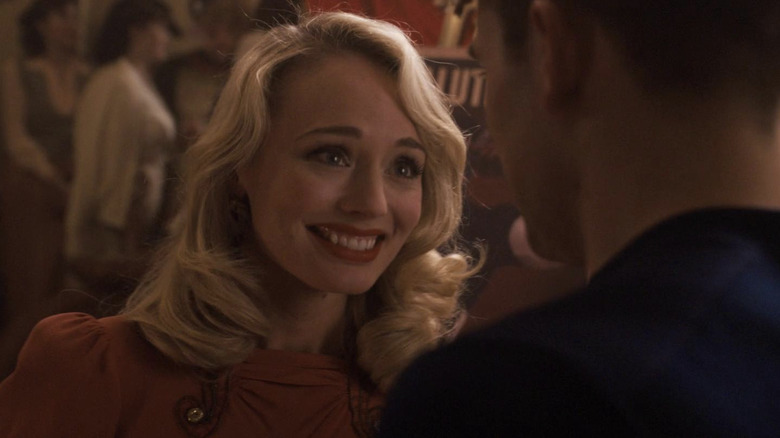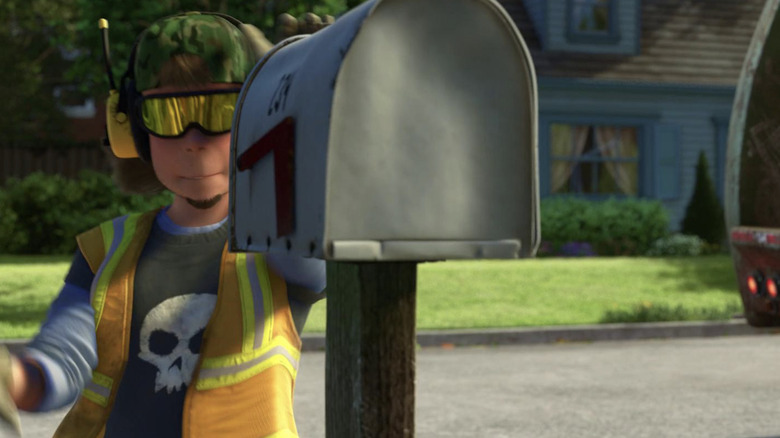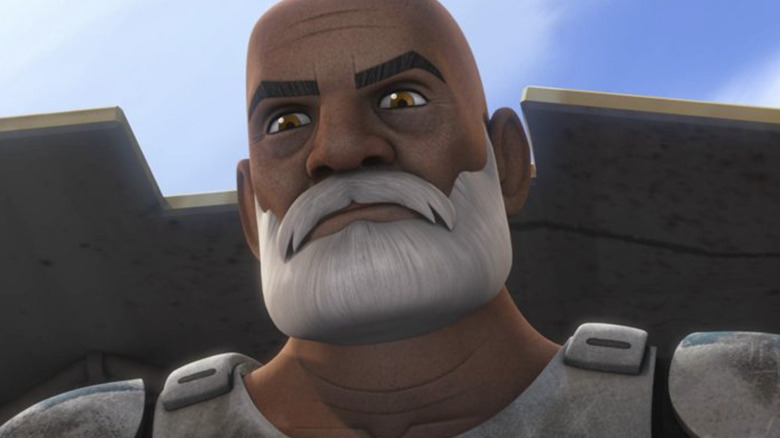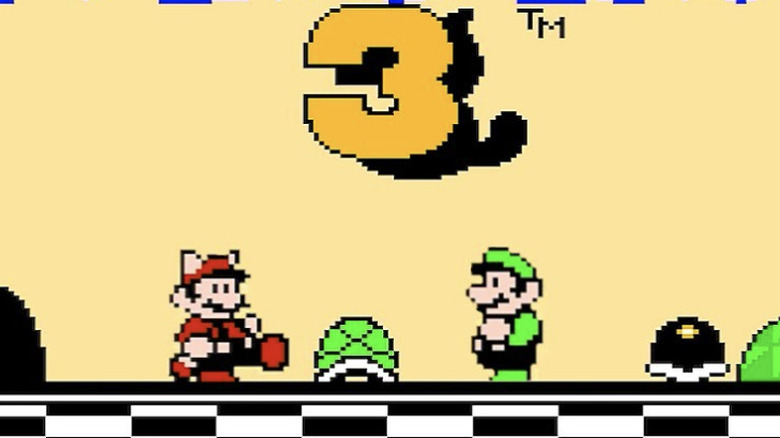Fan Theories Actors And Directors Actually Confirmed
When it comes to movies and television shows, we've all got our theories about the stuff no one else is noticing — a story's hidden layers, the creator's true intentions, and what the whole thing really means. There's just something incredibly gratifying about getting deep into the weeds of your favorite entertainment and examining the finest details of an intricate story, only to connect the dots on an obscure plot point that takes on an entirely new significance once you hold it up and really look at it from a different perspective.
Of course, it's then even more gratifying when an actor or director comes right out and tells you that — believe it or not — you were right! Unfortunately, this doesn't always happen, but when it does, you can expect a lot of minds to be seriously blown. Here's a look at some fan theories that actors and directors actually came out and confirmed, offering sweet vindication for some of the most passionate fans of their work.
Logan's ending was foretold in The Wolverine
Back in 2013, "The Wolverine" secretly spoiled the ending of 2017's R-rated "Logan" – at least, if you were paying close attention. The correct fan theory was proposed by Twitter user @_moegonzales3_, and the subtle spoiler goes like this: In one scene from "The Wolverine," Yukio, a mutant clairvoyant, tells the title character, "I see you on your back, there's blood everywhere. You're holding your own heart in your hand."
Now, fast forward to "Logan" and the title character does indeed die lying on his back, covered in blood — though he's not holding his literal heart in his hand. Instead, in a scene powerful enough to bring even the manliest of men to tears, Wolverine dies holding the hand of his cloned "daughter," X-23, also known as Laura. Then everyone in the theater wept.
Sure, it would be easy to write these two scenes' connection off as merely a fortunate coincidence. However, director James Mangold actually confirmed that the two scenes being linked was, in fact, always what he had in mind. When @_moegonzales3_ tweeted to Mangold: "you had this set up the whole time?!?!?!?!?!?!?" Mangold tweeted back: "And the prize goes to Maurice!" Fan theory confirmed.
Stan Lee is a Watcher
Anyone who watches Marvel movies was undoubtedly accustomed to the regular Stan Lee cameo. The comic book legend made an appearance in almost every Marvel movie ever made before his passing in 2018. Lee's cameos were always written off as merely nods to the Marvel man, as there wasn't really any canonical way to describe how Lee could appear in so many different places at so many different times. Or was there?
As fans have pointed out, there is actually one way Lee could have legitimately fit into all those films. For it to work, Lee must have been one of The Watchers — a race of aliens who observe and compile information on everything the universe has to offer, while strictly refraining from interfering. But, of course, this would be absurd, and Lee himself even denied it.
Well, "Guardians of the Galaxy Vol. 2" director James Gunn decided to have a little fun and make it legit. In the 2017 film, Gunn added scenes where Lee is regaling The Watchers with stories of his adventures. The director then confirmed to Radio Times that said scenes were related to the fan theory. "There's a lot of cool stuff that the fans come up with," Gunn said. "A lot of stuff I don't agree with ... But I find the idea that Stan Lee is a Watcher, or that he works for the Watchers, is just a fun little nod to the fans." Lee is even credited as "Watcher Informant," so as far as everyone's concerned, it's canon now.
Automobiles overthrew humans in Cars
While most people wouldn't think too deeply about a Pixar movie starring talking automobiles, some adults — and maybe even some kids — left theaters after watching "Cars" with a disturbing thought: where are the humans? After all, it's not like humans never inhabited the world of "Cars." Proof of human existence is littered throughout the entire movie. Aside from the fact that the cars themselves have handles, the action clearly takes place on Earth, with recognizable landmarks like Route 66 and Hollywood. Heck, we even see the American flag! So what exactly happened to us?
One fan theory proposed that the cars themselves eliminated humans. And as it turns out, that's exactly what happened. According to Jay Ward, creative director of the "Cars" universe, the anthropomorphic automobiles simply didn't need the dead weight. "Imagine in the near future when the cars keep getting smarter and smarter and after one day they just go, 'Why do we need human beings anymore? They're just slowing us down. It's just extra weight, let's get rid of them,'" Ward explained. "But the car takes on the personality of the last person who drove it ... There you go."
Now do you still want that hybrid? On the bright side, at least we know which cars Larry the Cable Guy, Jay Leno, and Owen Wilson will drive before the automobile uprising occurs.
Superman is haunted by those he could not save
Remember that epic battle in 2013's "Man of Steel," where Superman and General Zod duke it out? Do you know how many innocent people died during that titanic slugfest? According to director Zack Snyder (via ComicBook.com), "probably 5,000 people or something like that" died in "Man of Steel." After such a massacre, few people could live as though nothing ever happened, and even a Kryptonian like Superman carries demons.
In the first act of "Batman v Superman: Dawn of Justice," the Man of Steel saves a girl from a burning factory, and is then surrounded by people dressed like skeletons in celebration of the Day of the Dead, who all try to get their hands on the superhero. As one clever fan going by the name of The Kingslayer noticed (via Screenrant), this scene was deeply symbolic. "The symbolism of Clark being dragged down by the people who died during him and Zod's fight," they wrote, "symbolized by people dressed in skeletons, honoring the dead (maybe that's just my overthinking) ... superduper scene."
Snyder himself took the time to comment "no no that's right" on the original post. And he wasn't just being nice, either. Snyder intentionally wanted to focus on the human cost of these super battles, stating, "It's not just fun to crash around in a city. There's a human price. And I think that's the thing that weighs on Superman."
Frozen's Anna and Elsa are Tarzan's sisters
When "Frozen" co-directors Jennifer Lee and Chris Buck took to Reddit for an Ask Us Anything, they blew everyone's minds when they revealed that, despite the film's opening montage, Anna and Elsa's parents didn't actually die at sea. Instead, Buck stated the protagonists' parents "got washed up on a shore in a jungle island. The queen gave birth to a baby boy. They build a treehouse. They get eaten by a leopard..." Now, where have we heard that story before?
Disney fans made the Tarzan connection immediately, spawning the theory that feral child is actually the brother of "Frozen" sisters Anna and Elsa. As ridiculous (or not ridiculous) as that might sound, Buck confirmed the theory in an interview with MTV.
"I said, 'Of course Anna and Elsa's parents didn't die,'" she revealed, adding that Anna and Elsa's mother was pregnant when they left and gave birth to a little boy on the boat. "They get shipwrecked, and somehow they really washed way far away from the Scandinavian waters, and they end up in the jungle. They end up building a tree house and a leopard kills them, so their baby boy is raised by gorillas. So in my little head, Anna and Elsa's brother is Tarzan."
Spider-Man made his MCU debut in Iron Man II
There's been a long-running theory among fans of the Marvel Cinematic Universe that Peter Parker showed up even earlier than "Captain America: Civil War." As the theory goes, the little kid who dressed like Iron Man and confronted a robot at the Stark Expo in "Iron Man 2" is actually a young Peter Parker. "Iron Man 2" was released in 2010, after all, and everyone's favorite neighborhood web slinger is only in his mid-teens in 2017's "Spider-Man: Homecoming." Furthermore, the aforementioned Stark Expo takes place in Parker's hometown of Queens.
Still, because we never actually get to see the identity of the masked kid in question, it's easy to dismiss this fan theory as just a theory. Making it even more unlikely is the fact that the Spider-Man brand was still, at that time, clamped firmly in Sony's vice-grip.
Luckily, Tom Holland himself stepped in to save the day and confirm this awesome idea as MCU canon. The actor who plays Spidey told HuffPost, "It is Peter Parker." When pressed, Holland doubled down, saying "I can confirm that, that is Peter Parker." When pressed even further, Holland tripled down and spilled the beans. "I can confirm that as of today," he said. "I literally had a conversation with [Marvel president] Kevin Feige only 20 minutes ago. Maybe I've just done a big, old spoiler, but it's out there now. It's cool. I like the idea that Peter Parker has been in the universe since the beginning."
Chief is a demi-god in Wonder Woman
When "Wonder Woman" hit theaters, moviegoers everywhere were impressed by both Gal Gadot's performance and the overall quality of the film. Some, of course, even left the cinema with a few clever fan theories — perhaps the biggest one involving the supporting character Chief.
Chief doesn't get a particularly large amount of screen time in "Wonder Woman," but one specific scene has led to the popular fan theory that he is actually a demi-god. When Diana first meets Chief, they have a brief conversation in Blackfoot. Some of the conversation doesn't receive English subtitles, including the part where Chief apparently introduces himself as Napi, who — according to Native American lore — is a god of creation. So does that mean Chief is, in fact, a demi-god?
Well, according to Chief's actor, Eugene Brave Rock, the character is just that. When io9's Beth Elderkin took to Twitter to ask Brave Rock if "the character of the Chief is a demi-god as well, or was [the conversation] an inside joke between him and WW," the actor answered back, "Blackfoot culture hero and Demi-god." And just like that, it was a theory no longer.
Gilmore Girls' Rory and Caesar were classmates
When you think about fan theories, your mind probably jumps to the Marvel Cinematic Universe. Or Disney. Or "Game of Thrones." It probably doesn't make the leap immediately to "Gilmore Girls." But don't be fooled! The famous 2000s WB and CW show has a hardcore following, some of whom have dug into every minute detail the show has to offer. And with said hardcore digging comes some pretty hardcore fan theories — including one which offered up the idea that the show's main character, Rory, and Luke's chef, Caeser, were classmates.
The actor behind Caesar himself, Aris Alvarado, blew "Gilmore Girls" fans' minds wide open when he confirmed that this wild theory is indeed true. In Season 1, Episode 9, titled "Rory's Dance," we can briefly see someone who looks an awful lot like Caesar chillin' at a table with the rest of Rory's classmates. "That was Caesar," Alvarado declared to the crowd at a 2016 "Gilmore Girls" Fan Festival. "It's funny because [the internet] just discovered that. I've been waiting, I never wanted to say anything [so I could] see who was going to find me one day!"
Consider yourself found, Alvarado. Nothing gets by "Gilmore Girls" fans! Nothing.
The peddler in Aladdin is actually the Genie
There are a lot of Disney theories floating around in the ether. One of the most popular ones out there, however, is that the Genie in "Aladdin" is actually the peddler from the beginning of the film. As it turns out, that one is completely true!
When discussing fan theories with E! News, "Aladdin" director Ron Clements let the cat out of the bag — or, perhaps, the genie out of the lamp — when it comes to the popular fan theory. "That's true! That was the whole intention, originally," Clements revealed, continuing, "We even had that at the end of the movie, where he would reveal himself to be the Genie, and of course Robin [Williams] did the voice of the peddler. Just through story changes and some editing, we lost the reveal at the end. So, that's an urban legend that actually is true."
Nevertheless, don't get too excited. Not all of your "Aladdin" theories are true. For instance, the film's title character never said "take off your clothes." But hey, not every conspiracy can be a winner!
RoboCop is a Christ allegory
Believe it or not, some people believe that the Paul Verhoeven-directed "RoboCop" was nothing more than an allegory concerning the death and resurrection of Jesus Christ. How folks get that from an uber-violent action flick about a dead Detroit cop who's turned into a killer cyborg is beyond us, but it quickly gained traction. As the theory goes, Alex Murphy (Peter Weller) dies in the line of duty only to be resurrected to save his world.
But what's even stranger is that Verhoeven himself confirmed this theory to MTV a few decades after the film's release. "The point of 'RoboCop,' of course, is it is a Christ story," the "RoboCop" director revealed. "It is about a guy that gets crucified after 50 minutes, then is resurrected in the next 50 minutes and then is like the super-cop of the world, but is also a Jesus figure as he walks over water at the end." Since Christ is the ultimate peacemaker, it's not exactly a surprise that this super-cop might want to emulate the Son of God, but the allegory goes even further.
"I put something just underneath the water so [Peter Weller] could walk over the water and say this wonderful line... 'I am not arresting you anymore.' Meaning, 'I'm going to shoot you.' And that is of course the American Jesus." American or not, Christ is considered a warrior in the Book of Revelation, so Verhoeven might have been more correct than he knew.
Deckard is a replicant in Blade Runner
One of the longest-running fan theories in all of film history is that "Blade Runner" actually ends with the reveal that Harrison Ford's Rick Deckard has been a replicant the whole time. A heated debate among audiences ever since the science fiction epic first premiered in 1982, the idea is so controversial that the 2017 sequel "Blade Runner 2049" refuses to answer the question. Instead, the movie focuses on another replicant named K (Ryan Gosling) as he deals with his own artificial status.
But the original film's director Ridley Scott had other ideas. "He's a replicant," Scott revealed in the 2000 documentary "On The Edge of Blade Runner," explaining that Deckard's vision of a unicorn, paired with the figure at the end, signifies as such. No doubt, Scott's intended ending is highly controversial among fans, but it's also been a debate among those involved with the sci-fi franchise, particularly Harrison Ford himself.
Yet after years of arguing back and forth about his character's true origins, Ford gave into Deckard's fate. In a 2023 interview with Esquire, Ford finally admitted that Scott was right all along. "I always knew that I was a replicant," he said. "I just wanted to push back against it though. I think a replicant would want to believe that they're human." What finally changed Ford's perspective, we may never know, but now it's been confirmed: Deckard was not a real boy after all.
Dumbledore is gay
Ever since "Harry Potter" first began, author J.K. Rowling has been the subject of intense criticism and controversy. While today's controversies are of a different sort, back in 2007, the fantasy writer revealed that a popular theory among Potterheads was true all along: Professor Dumbledore is gay. Though this isn't touched upon too much in the first batch of novels or films, Rowling revealed this fact at a Q&A back in 2007, around the same time the book series ended.
"In fact, recently I was in a script read-through for the sixth film," she told her fans (via ABC News), "and they had Dumbledore saying a line to Harry early in the script, saying, 'I knew a girl once, whose hair–'" After being interrupted by laughter, Rowling continued, "I had to write a little note in the margin and slide it along to the scriptwriter — 'Dumbledore's gay!'" Though this didn't affect much concerning the "Harry Potter" books or films, it did play a major role in the Wizarding World prequel series "Fantastic Beasts."
Taking place in the late 1920s and into the early 1930s, the "Fantastic Beasts" trilogy, though not strictly about Jude Law's Dumbledore, details his life and the results of his "tragic" romance with Gellert Grindelwald. With only three out of the reported five films released, we won't know the full story for a while (if ever), but fans were certainly pleased when they discovered that their hopes for the wizard were true.
Aquaman once saved Superman in Man of Steel
When "Man of Steel" first premiered in 2013, fans instantly took to the internet to claim that when Clark (Henry Cavill) was thrown into the ocean following the oil rig explosion, none other than Aquaman had saved his life. At the time, there was no basis for this. "Justice League" hadn't even been announced, and although fans hoped for a live-action DCEU, it had yet to be realized. Nevertheless, the theory gained traction, especially after being referenced in the animated "How It Should Have Ended" short.
Once Jason Momoa was cast as Aquaman and director Zack Snyder dropped an official image of the DCEU's King of Atlantis, the theory picked up steam again. It wasn't until 2017 when Momoa, promoting "Justice League" on DC All Access, confirmed this wild fan theory to be true. "In 'Man of Steel' when [Superman is] on the oil rig, he's holding that up and then all of a sudden you see him up on the ocean, kind of floats up on the ocean. [Zack Snyder told me], 'I had [Aquaman] save him,' so that they'd get to cross paths at one point so when Bruce goes, 'You ever heard of [Superman]?', I have."
This wasn't the only time that Aquaman saved Superman though, as the League would go on to resurrect him in their 2017 team-up film. Still, it's a fun nod that shows just how interconnected the initial vision for the DCEU really was.
The Incredibles had various powers when they were young
At the end of "The Incredibles," it's revealed that the baby Jack-Jack has a plethora of superpowers that seem to come out of nowhere. While most supers only have a single power or maybe two, the youngest member of the Parr family has something around 17 known abilities, many of which are further explored in "The Incredibles 2." But given that the other heroes only have one ability each, it's led fans to wonder if young children of supers have a bunch of them at their disposal until a certain age determines which super ability they'll keep.
YouTuber Seamus Gorman asked director Brad Bird in 2018 if the other Parr kids likewise had multiple powers as children. "I mean, the idea of 'The Incredibles' is that you use powers to comment on roles within the family," Bird explained, saying that Mr. Incredible's super strength is due to the expectation of fathers to be strong, just as Elastigirl's powers are meant to represent how moms are generally stretched thin. "The idea of babies is that they're unknown potential ... You don't know!" he added.
Though Bird doesn't explicitly confirm this fan theory, his explanation about how powers work leads us to believe that when Violet and Dash were babies, they too likely had multiple abilities. Of course, once their potential is realized, their powers are chosen for them, and the rest is alternate history.
Captain Hook was once a Lost Boy
If you thought that Captain Hook in "Peter Pan" was strictly a villain, that may not be the whole truth. According to a fan theory by Redditor u/ruven95, Hook was once a Lost Boy himself before he and his not-so-merry band of pirates grew up. But unlike most adults, who put their childish dreams behind them, they became the pirates they wished to be in their youth. But that isn't the darkest part of these theories. u/Arloste noted in 2013 that Peter Pan "thins" his group of Lost Boys when they begin to grow up. To escape the boy's wrath, Hook and his crew became pirates.
It took a long time for Disney to confirm this theory, but in the 2023 live-action remake "Peter Pan and Wendy," Hook (played by Jude Law) reveals that he was once a Lost Boy who wanted to leave Neverland to find his mother, only to grow up in the process. Raised by pirates, Hook eventually returned to Peter (Alexander Molony), who couldn't see past his grown-up features. The two then became sworn enemies, fated to battle one another in Neverland forever. Sort of.
Of course, this is Disney, so the movie ends with them making amends, but knowing that this long-time theory has been somewhat confirmed is exciting nonetheless. Still, its crazy to think that it took over a century for Captain Hook's backstory to be fully revealed — well, at least the Disney version.
Every Quentin Tarantino movie takes place in the same universe
Just like nearly all of Stephen King's stories take place in the same universe, so too have fans often wondered and speculated the same about the films of Quentin Tarantino. There are a number of Easter eggs in his movies that seem to imply this, such as the Big Kahuna Burger — which appears in "Pulp Fiction," "Reservoir Dogs," and "From Dusk Till Dawn" (which he wrote) — and the Red Apple cigarettes seen in "Kill Bill" and "Once Upon A Time In Hollywood." But it wasn't until 2016 while promoting "The Hateful Eight" that Tarantino would confirm this himself, albeit with a twist.
"There is actually two separate universes," the director revealed on the Australian talk show The Project. "There is the realer than real universe, alright, and all the characters inhabit that one. But then there's this movie universe." Tarantino went on to explain that fantastical projects such as "Kill Bill," "Death Proof," and "From Dusk Till Dawn" make up the fictional cinematic universe that exists as a part of his "normal" cinematic universe. Which films make up the latter have yet to be revealed, but it's certainly an interesting concept.
This all makes a lot of sense when we consider the "Fox Force Five" pilot mentioned by Uma Thurman's Mia Wallace in "Pulp Fiction." Obviously, she's referencing the "Kill Bill" story, which in Tarantino's "real-verse" is nothing but an onscreen adventure, much like in our own.
There was almost a live-action Marvel universe before the MCU
Do you remember Marvel movies from before the MCU? It's hard to recall, now that we have so many to choose from, but there was a time when they featured the only Marvel heroes we knew. Although Marvel had divided their film right across multiple studios, many fans still believed that movies like Sam Raimi's "Spider-Man," Bryan Singer's "X-Men," and Tim Story's "Fantastic Four" shared a cinematic universe of their own, including Redditor u/Beneficial-Piano9756, who connected some of the dots.
Among them is a deleted scene from 2005's "Fantastic Four," in which Ioan Gruffudd's Reed Richards briefly extends his features to look like Hugh Jackman's Wolverine. According to Jackman, he very nearly cameoed in 2002's "Spider-Man" as well. Of course, 20th Century Fox was behind the "X-Men" and "Fantastic Four" films, soon adding "Daredevil" and its spin-off "Electra" to its arsenal, while Sony produced "Spider-Man" and the Nicolas Cage version of "Ghost Rider." No wonder fans wanted to see this happen. But after the advent of the MCU, all seemed for naught.
With Spider-Man recast and the X-Men seemingly abandoned, old Marvel died away. That is, until the multiverse arrived and we learned that Tobey Maguire's Spider-Man is a part of the greater MCU, as is Patrick Stewart's Professor X and soon Jackman's Wolverine. With countless universes out there, these stories might not all exist in the same world, but they are officially a part of the same multiverse.
Captain America met Star-Lord's grandmother
One crazy fan theory that came out after the release of "She-Hulk: Attorney at Law" was that Captain America (Chris Evans) once got together with Star-Lord's (Chris Pratt) grandmother back in the 1940s. After Bruce Banner (Mark Ruffalo) reveals to his cousin Jennifer (Tatiana Maslany) that Cap hooked up with a woman while on tour during the Second World War, fans flocked back to "Captain America: The First Avenger" for proof. Sure enough, there was a strange connection to another MCU flick that most didn't get the first time around: Laura Haddock.
Haddock played an "Autograph Seeker" who looked dreamily into Cap's eyes in the hero's origin flick, only to later be cast as Peter Quill's mother Meredith in "Guardians of the Galaxy," reprising the character again in the sequel. Not only do these two women look identical, but director James Gunn took to X (formerly known as Twitter) to confirm the speculation. "That's Quill's grandma," Gunn said in a now-deleted tweet. "I just made this up."
But later on, Gunn reworked the theory after fans noted that the timeline didn't match up. "Laura's character who met Cap in 1943 would be way too young," he concluded in another tweet. "Meredith Quill was born in late 50's/early 60's." One user then asked if Haddock's character in "The First Avenger" could be Meredith Quill's great-aunt instead, to which Gunn replied, "Sure why not."
Sid is the garbage man in Toy Story 3
One particularly charming fan theory that blossomed after the release of 2010's "Toy Story 3" was that the garbage man that Woody (Tom Hanks) hides from during the first act is actually Sid Phillips, the somewhat creepy child who terrorized our plastic heroes in the first movie. In "Toy Story," Sid learns of the existence of sentient toys after they turn on him for deforming them, but years later, fans pointed out that he'd moved on. Clad in the same skull logo T-shirt from his youth, the older Sid seems much happier and better adjusted to life in "Toy Story 3."
As it turns out, director Lee Unkrich confirmed that this was Sid way back in 2010 on the official DVD commentary. "Why not make this Sid?" Unkrich explained (via YouTube). "So we gave him the same old T-shirt." The director went on to note that this may not actually make a whole lot of sense given that Andy's family moved at the end of "Toy Story," but explained that they probably didn't move very far.
"We actually called Erik von Detten, who was a young boy when we made 'Toy Story,' and asked him if he'd be interested in coming back and doing a little cameo in 'Toy Story 3,'" Unkrich added. Obviously, von Detten was happy to return to the role that kickstarted his career, and the rest is Pixar history.
Star Wars: The Clone Wars legend Captain Rex was at the Battle of Endor
Since 2015, a fan theory about the fate of "Star Wars: The Clone Wars" icon Captain Rex has circulated around the internet. It all started when the character, now sporting a white beard, appeared in "Star Wars Rebels," set a number of years before "Return of the Jedi." From there, fans speculated that Rex was retroactively the Rebel soldier Nik Sant, who appeared only in "Return of the Jedi" during the Battle of Endor. Future projects seemed to confirm this, with the epilogue of "Rebels" mentioning that Rex was present at that pivotal conflict.
Elaborating on the theory, a 2019 episode of "Star Wars: Galaxy of Adventures" shows Rex alongside Han Solo and the Rebels on Endor, something later expanded on in the 2021 children's book "I Am a Clone Trooper." To make matters more confusing, "Star Wars" guru and George Lucas' "Clone Wars" partner Dave Filoni has noted that he believes Nik Sant and Rex are the same guy, saying, "I think the one thing I have really thought about is I really do think that Rex is that guy on Endor. I really do."
Nevertheless, Filoni refuses to change "Star Wars" canon on a whim. "I didn't want to lay it down in stone," he told IGN after the end of "Star Wars Rebels." "I think I left it in a state where you could believe one way or the other."
Super Mario Bros. 3 was a stage play
One of the strangest Mario theories ever dreamed up is that the 1988 video game "Super Mario Bros. 3" was actually a stage play put on by the characters. It's an odd one to be sure, but when you consider the bolted blocks, hanging backgrounds, all of the curtains, and the fact that Mario exits stage right, it all comes together. Reddit user u/emitremmus27 even included a visual aid in his claims, with one user commenting that, when the game is finished, the characters all take a bow before the final curtain.
As outlandish as this might sound, it's actually completely true. In a Q&A on the X platform with Nintendo's U.K. account, Shigeru Miyamoto, the man who invented Mario, confirmed this theory. "YES," he replied after being asked if the game was all a performance (via Kotaku). It doesn't get much simpler than that. When you consider all the wild and inventive things the Mario games have done over the years (no, we're not counting that live-action "Super Mario Bros." movie), it shouldn't come as a complete shock, but it is a fun fan theory that turned out to be right on the money.
With Mario's recent return to the big screen (successfully this time), we'll likely be seeing more of our favorite plumber and his scaredy-cat brother. Maybe in the next movie, the characters will put on a performance of their own.
